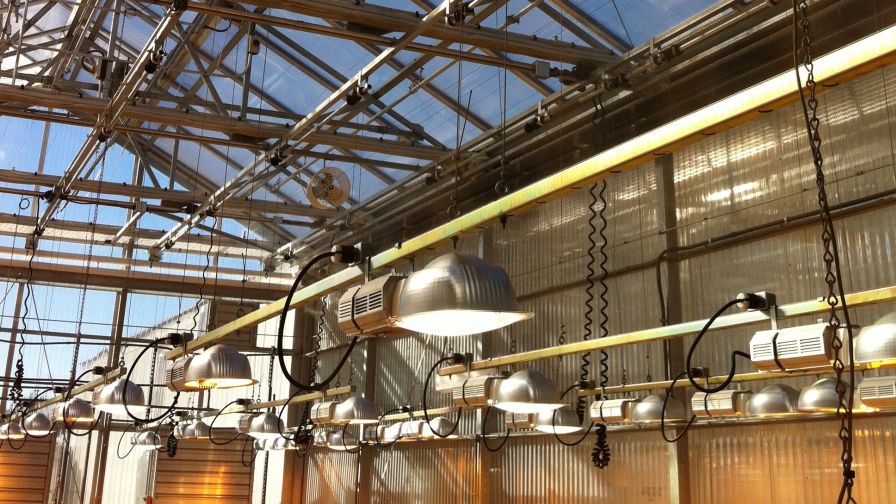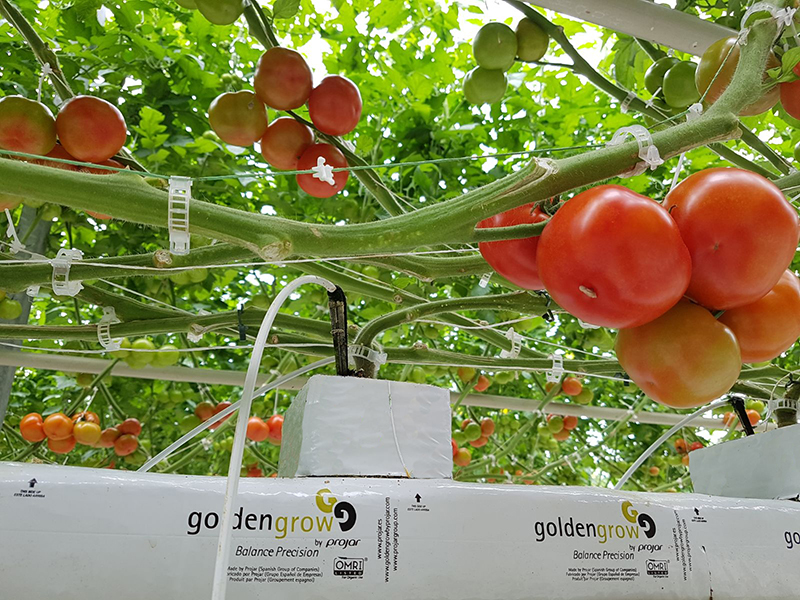Follow These Innovative Pathways to Digital Horticulture

The future of greenhouse lighting controls uses adaptive daylighting controls to adjust light intensity, maximizing energy efficiency while hitting photoperiod, light intensity, and daily light integral crop requirements. Photos: Rob Eddy
More farms are cultivating crops in advanced greenhouses that involve enhanced structural configuration, environmental control, crop production, material handling, labor utilization, resource allocation, and return on investment. At the same time, industry standards and energy codes have emerged that drive the industry to automate and control greenhouse facilities.
Labor is always the number-one cost for growers, and is the highest cost for greenhouse growers. The results of Greenhouse Grower’s 2021 State of the Industry survey indicate that labor challenges and COVID-19 have encouraged more operations to invest in automation. About 36% of respondents said that their facilities are investing in more automation, and 26% are not right now, but are thinking about doing so in the future.
It has always been difficult to find skilled labor, and it is extremely hard now as the industry has boomed. The impacts of the pandemic make it even harder for businesses to compete for qualified workers and manage their bottom line. 65% of respondents rated labor as the greatest crop production challenge businesses are facing, and automation is a key strategy to relieve overworked staff and meet new operating requirements imposed during the pandemic.
Many growers see protection and automation as ways to overcome the second most challenging barriers for businesses: production space and insect control. 55% of respondents plan to invest in greenhouse structures in 2021, and more than 30% plan to invest in crop protection. Many growers are battling issues with dynamic conditions and extreme weather events and are seeking to maximize quality and yields in more advanced greenhouses with better controls.
Advanced greenhouse facilities may use higher-tech infrastructure like sealed and automated building envelopes, HVAC systems, LED horticultural lighting systems, irrigation systems (including hydroponics), and controls hardware and software to more precisely manage environmental conditions. Advanced greenhouses may also demonstrate operational optimization of labor and materials without the use of sophisticated infrastructure.
The results of the 2018 Autonomous Greenhouse Challenge found that artificial intelligence (AI) and automated control can serve indoor farming needs. When growing cucumbers, the winner was one of the four teams of robots controlled by AI, achieving 6% higher yields and 17% higher net profits. The second-place team of experienced human growers still performed well and achieved high yields, but was outperformed by robots controlled by an AI team with little experience growing the crop.
In its third year, 46 teams competed in the challenge by using machine learning climate control algorithms in a virtual greenhouse. Teams used computer vision and autonomous controls to determine HVAC and lighting setpoints to cultivate lettuce and maximize profitability. The 2021 winners of the Autonomous Greenhouse Challenge, Team Koala, built an algorithm that realized a virtual net profit of $0.94 per square foot of lettuce canopy. The next step of the challenge is the physical growing phase that starts in early 2022, where teams will grow real lettuce completely autonomously in Wageningen University Research greenhouse compartments.
The Future of Environmental Controls
According to Resource Innovation Institute Technical Advisory Council member Energy Solutions, automation provides labor, productivity, and energy benefits by utilizing data points to drive facility environmental controls and optimize the performance of environmental systems relative to the crop being grown. Automated greenhouses require controls that can tailor environmental conditions to plant growth requirements and characteristics.
Energy Solutions maximizes energy and greenhouse gas reduction impacts by supporting market transformation throughout a technology’s product maturity cycle. Emerging technologies are monitored to verify performance and accelerate market adoption of the new technology. Established technology energy savings impacts are scaled up through market-based program delivery models such as midstream and upstream. Codes and standards are implemented to lock in savings across entire regions through local, state, and federal building codes and appliance standards.
Energy Solutions notes that while greenhouse HVAC systems may have started out as vents, circulation fans, and exhaust fans, greenhouse ventilation is evolving to include several other technology options. High performance greenhouse designs like those manufactured by RII Technical Advisory Council member Ceres Greenhouse Solutions are utilizing geothermal systems under the greenhouse floor to efficiently heat and cool greenhouses. These HVAC systems more closely resemble the high-efficiency designs utilized in high-end residential and commercial buildings than traditional greenhouses.
Vapor pressure deficit (VPD) control sequences are also becoming more popular for some crops. This type of control scheme modulates the temperature and humidity of a room to drive evapotranspiration of the plants. This can allow facilities to run at higher temperatures and humidity levels, reducing energy required for cooling and dehumidification while still achieving optimal environmental conditions for plants.
For lighting, the future of greenhouse lighting controls uses adaptive daylighting controls to adjust light intensity, maximizing energy efficiency while hitting photoperiod, light intensity, and daily light integral (DLI) crop requirements. According to adaptive lighting controls manufacturer Candidus, when growers have new technology and automation, they will stay in business and be successful as other growers produce at a higher cost.
Energy efficiency programs like those administered by National Grid are providing financial incentives for lighting controls technology while programs in states like Georgia and California are studying energy savings of these technologies so they can offer rebates in the future.

While greenhouse HVAC systems may have started out as vents, circulation fans, and exhaust fans, greenhouse ventilation is evolving to include several other technology options such as motorized side vents.
Winds of Change
Some State of the Industry survey respondents may have to deal with upcoming code changes if they start projects in 2023 or later. The California Energy Code, Title 24, Part 6, is getting updated for greenhouses and indoor farms, and the requirements apply to new construction and major retrofits starting Jan. 1, 2023. It does not apply to existing buildings unless a site is making major renovations that trigger alterations requirements in the Energy Code.
Energy Solutions was the lead CASE author for the 2022 CA Title 24, Part 6 Controlled Environment Horticulture (CEH) CASE Report that proposed energy code changes for greenhouses that address coverings and horticultural lighting. Senior Engineer Kyle Booth notes that California growers should start looking at the timing of any new construction or major retrofit projects. If the project permit is pulled after Jan. 1, 2023, then growers will need to make sure their proposed equipment meets minimum efficiency requirements. The Energy Code Ace website is a great resource for compliance with the California Energy Code. Visit the Statewide Codes and Standards Team website at Title24stakeholders.com for more details on the Energy Code and future code cycle proposals.
The national standard for energy-efficient buildings, Standard 90.1, is maintained by ASHRAE with input from other standards organizations. In June 2021, the ASHRAE Standard 90.1 lighting subcommittee passed a standards addendum that proposed horticultural lighting efficacy and controls requirements similar to those that were recently adopted in the 2022 California Energy Code. In October 2021, the Resource Innovation Institute and members of their Technical Advisory Council submitted public comments to improve the code for greenhouse growers.
When 90.1 changes, the energy codes across North America change. 90.1 is specified by state and local governments when policymakers create regulations for buildings in their region. Updates to the standards may affect growers across the country when it is updated in 2022 to incorporate addendums. Depending on the timing of regional code cycle updates, as jurisdictions adopt the addendum addressing horticultural lighting equipment and controls, greenhouse growers may have local building codes that reference 90.1 affecting retrofits and new construction as soon as 2022, or in the next few years. To learn about how the ASHRAE model code development process works, visit the ASHRAE 90.1 website.
As codes adopt requirements for technology and mandate controls approaches, incentives from energy efficiency programs may get smaller or disappear entirely. It is important for growers to actively engage their utilities to get support for implementing autonomous growing solutions in their facilities. It is also in the best interest of producers to stay apprised of changes in standards and codes, so they can competitively plan projects and maximize financial benefits from rebate programs.
Learn tips for automating greenhouses in Resource Innovation Institute’s newest peer-reviewed Best Practices Guide on Automation & Controls for Cannabis Producers at ResourceInnovation.org/Resources. Consider benchmarking your greenhouse operation with PowerScore. Dig deeper by joining RII and participating in our Technical Advisory Council working groups.










